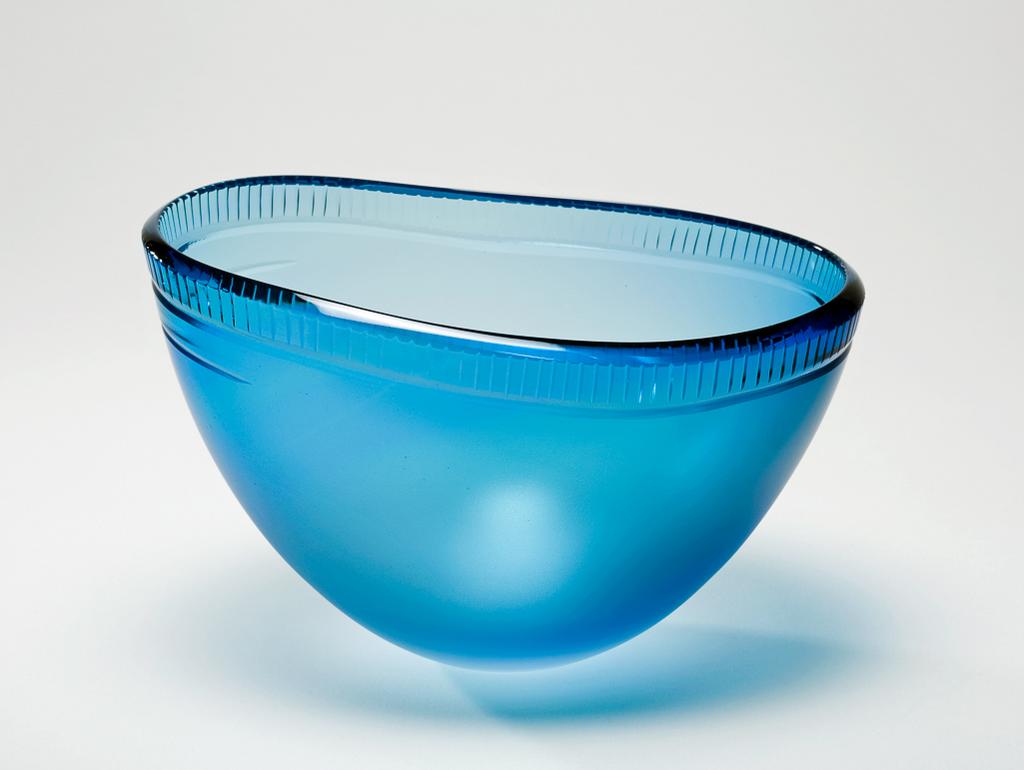Current Location: In storage
Titles
Barge
Maker(s)
Glassmaker:
Fladgate, Deborah
Entities
Categories
Description
Blown pale Prussian-blue glass, sand-blasted and cut. The bowl stands on a narrow circular base. The deep, curved sides rise to an oval rim which is higher at one end than at the other. The base is clear and polished, the exterior is frosted, except for a border below the rim, which is cut with close-set vertical cuts, below which is a cut horizontal band. Below that, at the higher end, there is a short cut horizontal line.
Notes
History note: Contemporary Applied Arts, 2 Percy Street, London, W1P 9FA
Legal notes
Given by Sir Nicholas and Lady Goodison through the National Art Collections Fund
Measurements and weight
Height: 11 cm
Length: 17 cm
Acquisition and important dates
Method of acquisition: Given
(1997-12-05)
by
Goodison, Nicholas and Judith
Dating
20th Century, Late
Elizabeth II
Production date:
AD 1996
Note
Text from object entry in A. Game (2016) ‘Contemporary British Crafts: The Goodison Gift to the Fitzwilliam Museum’. London: Philip Wilson Publishers: Deborah Fladgate studied Ceramics at West Surrey College of Art and Design followed by an MA in Glass at the Royal College of Art, London. On graduating, Fladgate worked at Cowdy Glass Workshop with Pauline Solven (34) in Gloucestershire and with Anthony Stern (b.1944) in London. Fladgate established and ran an independent hot-glass studio making domestic tableware and individual forms in London and Surrey before setting up her studio in Scotland in 1994, which she ran until her retirement in 2011. In the late 1990s, Fladgate developed a series of glass vessels inspired by the forms of fishing boats along the Fife coast near her studio. The Barge Bowl was one of the earliest of this series. The form was blown, cased inside with colour and, following cooling, sandblasted and the rim carved to shape. The V-shaped cuts were made on an intaglio lathe using carborundum and stone wheels, then fire polished. This latter technique involves reheating the piece slowly in a small kiln and picking it up on the end of a hot punty iron, then warming for a few moments in the intense heat of the glory hole. This gives the brilliant shine to the cut surfaces. Deborah Fladgate: ‘There are always concerns each piece has to fulfil – the weight, the balance, the surface qualities and the way light is captured in the glass. Scale has never been a distraction – my pieces are more intimate objects to be not just looked at but looked into.’
This is one of a series of bowls inspired by boat forms.
School or Style
studio glass
Contemporary Craft
Components of the work
Decoration
Materials used in production
Blue glass
Inscription or legends present
- Text: Deborah Fladgate G 96
- Location: Outside the outline of the base
- Type: Signature
References and bibliographic entries
Identification numbers
Accession number: C.100-1997
Primary reference Number: 27232
Stable URI
Audit data
Created: Saturday 6 August 2011
Updated: Tuesday 30 April 2024
Last processed: Tuesday 13 May 2025
Associated departments & institutions
Owner or interested party:
The Fitzwilliam Museum
Associated department:
Applied Arts




